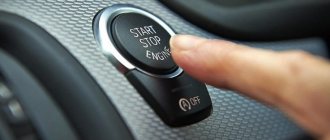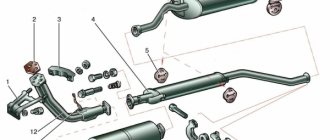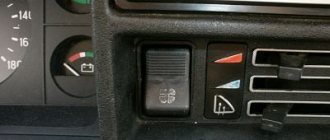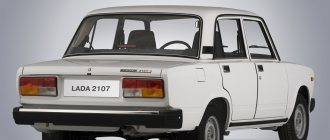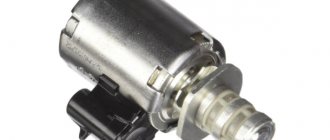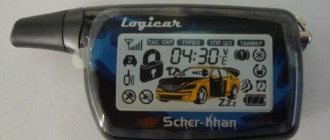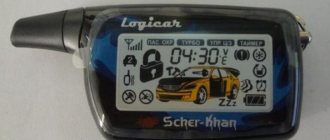Before a novice motorist gets behind the wheel and gains practical driving skills, it is necessary for the beginner to study the rules of the road and basic technical disciplines regarding the general structure of the car.
More precisely, you need to know about the operating principles of the main components that make up the car. Although the latter is not required to be studied according to regulations, this knowledge will not be superfluous for future motorists.
In this article we will look at how to drive an automatic car for beginners, the principle of operation of an automatic transmission, rules for using an automatic transmission, switching operating modes of an automatic transmission, etc.
Using other driving modes on an automatic for beginners
Modes “1”, “2” and “3” are selected based on the vehicle’s driving conditions. Some are convenient for towing heavy loads, while others are suitable for descending steep mountains. Let's look at each of them in more detail.
The inclusion of the “third” mode tells us that the automatic transmission operates in three-speed mode. In this mode, the car can move at any speed, but not higher than third. Driving in mode “Three” allows you to accelerate to a maximum of 150 km/h.
It is preferable to drive in this gear when your car is heavily loaded, as well as when driving around the city.
The “second” driving mode is also limited at upper speeds. When driving in mode “2”, only the second and first speeds are used. There are cars that combine “second” speed with “winter” mode. In this case, the car starts and moves only in second gear.
In most cases, the “deuce” is used on slippery roads, off-road or when towing. The maximum speed at this value is limited to 90 km/h. It is also convenient to move in second gear using engine braking when you have to go down a steep slope or a long climb has begun.
The “first” selector mode has the highest gear ratio, which is suitable for driving at low speeds, namely only in first gear.
At this speed, you can safely drive on loose snow, sand or washed-out roads at a speed not exceeding 45 km/h. This mode is also convenient for getting out of snow, sand or mud if the car is stuck.
If this happens and the car is slipping, then you should not apply gas. Try to “rock” the car by moving forward at first speed and back alternately. You can try to find better grip by turning the steering wheel from side to side. Also monitor the speed and revolutions on the tachometer, they should not be high, and the numbers on the speedometer should not be raised more than 30 km/h.
Useful links:
- "Tips for novice drivers"
- “Ten basic rules for safe driving in a modern city”
- “How to quickly get a license: buy, study, conditions. Advice from the director of a driving school"
Tweet
Call us and get a free consultation!
+7 (495) 122-00-15
Future motorcyclists can take the theoretical course at any of the 58
training classes of the Central Driving School of Moscow, located in all districts of Moscow in places of best accessibility.
To attend lectures, you can choose any of the offered options: weekdays - morning / evening, weekends - morning / afternoon
.
And you can also combine them and create an individual lesson schedule
!
To consolidate the material you have studied or work on missed topics, you can take advantage of online training
.
Motorcycle driving lessons at the driving school are held at indoor motor racing tracks
.
Moreover, classes take place all year round
, in any weather conditions.
During classes, all students are provided with
the necessary
protective equipment
.
The total duration of the practical motorcycle driving course is 18 hours. For these classes you can choose any day of the week (including weekends)
, from 7 a.m. to 10 p.m.
Practical classes are held on new Yamaha, KTM and Honda motorcycles
under the guidance of professional instructors and famous motorsportsmen.
During practical training you will learn:
- Drive confidently and choose the right pace.
- Maintain balance at slow speed in several ways and in combination.
- Correctly place your gaze when performing elements.
- Automatically perform all exercises.
Automatic transmission operating modes
Let's look at the automatic transmission modes.
P
Parking
. In this mode, the shaft and, accordingly, the drive wheels are blocked. Use this mode during long stops or when you leave the car. You can switch to this mode only after the car has completely (!) stopped.
Reminder!
To move the gear lever from position
“P”
to another position, you must press the brake pedal!
Attention! Never turn on this mode while the car is moving! This may cause the box to break!
If you leave the car on a relatively flat surface, then there is no need to use the handbrake. If the slope is steep enough, then to reduce the load on the elements of the parking mechanism, it is best to proceed according to the following scheme:
- Setting up while holding the brake, pull the handbrake,
- release the brake, the car will most likely move a little,
- switch the box to position “P”
,
Removal
- first switch the gearbox lever to driving mode,
- then, while holding the brake, release the handbrake
R
Reverse.
This mode is used for reversing. You can switch to this mode only after the car has come to a complete stop and the brake pedal is pressed.
Attention! Switching the box to this mode while moving forward will lead to failure of the gearbox and other elements of the transmission and engine!
N
Neutral gear.
This gear is used only for technical needs, when it is necessary to move the car over short distances with the engine running, for example, in a car service center. If you need to have your vehicle towed, see the section on.
Many people believe that when coasting down a hill, you can save some fuel by switching the transmission to this mode, but this is not true, because then you still have to switch to mode D
, which will put additional load on the box.
Also, when driving an automatic, it makes no sense to move the lever to the neutral position during short stops, for example at traffic lights.
D
Basic driving mode.
Most often, this mode is used to move forward. On an automatic transmission, this mode is suitable for driving at any speed available to the car, from “0” to maximum.
2
Only the first 2 gears.
This mode is recommended when driving on winding mountain roads or when towing a trailer or other vehicle. Do not switch to this mode if the vehicle speed exceeds 80 km/h.
L
First gear only.
This mode is used for particularly difficult road conditions, such as off-road driving. You should not switch to this mode if the vehicle speed exceeds 15 km/h.
Lock as a precaution when driving an automatic car
Driving an automatic for beginners requires careful attention to the vehicle's driving modes. Thus, you should remember a few simple rules:
The automatic transmission lever is designed with some safety measures
If the automatic transmission lever switches to certain modes without pressing the lock button, this means that the lever can be moved into these ranges both when the car is moving and when starting off. If the lever is moved to a certain mode only by pressing a button on the selector, then this indicates that some precautions must be taken to perform this action. Thus, with the selected driving mode “1”, it is possible to safely move the lever to position “2”, and then switch it to range “3” or “D” on the move, without stopping your vehicle
However, it is worth noting that switching the lever from the “Third” position to the “Second” or “First” is already accompanied by pressing the latch. This is done to prevent damage to the box if the driving mode is incorrectly selected. Otherwise, the machine will be subjected to significant overloads, which will inevitably lead to its breakdown.
Thus, with the selected driving mode “1”, you can safely move the lever to position “2”, and then switch it to the “3” or “D” range on the move, without stopping your vehicle. However, it is worth noting that switching the lever from the “Third” position to the “Second” or “First” is already accompanied by pressing the latch. This is done to prevent damage to the box if the driving mode is incorrectly selected. Otherwise, the machine will be subjected to significant overloads, which will inevitably lead to its breakdown.
Therefore, to correctly switch between modes in this order, it is necessary to either stop completely or slow down the speed of the vehicle. Thus, switching the lever from position “Two” to “Third” gear without using a locking button is impossible; compliance with restrictions is required. Namely, you cannot use such a combination when driving above a speed of 70 km/h, so as not to damage the transmission. Although in new automatic transmission models this nuance seems to have been removed, so switching when driving even at high speeds will not bring much harm, even if the switch is incorrect.
That's all we wanted to say on this issue. Driving an automatic transmission for novice drivers causes difficulties only at first, which cannot be said about a manual transmission. First you need to understand the modes of your transmission. In any case, all the necessary recommendations for using the automatic transmission capabilities of a specific car model are available in the service documentation. Such documents usually “come” with the car upon purchase, or can be found by make and body number on the Internet.
Gas pedal
The main feature of working with the gas pedal is that you also work with it with your right foot, just like with the brake pedal . Since there are no situations that require the simultaneous use of gas and brake (except for a launch start, more about which below).
Gas pedal
Remember, when driving a car with an automatic transmission, your left leg is always at rest. All control occurs exclusively with the right hand.
Position of the left foot when driving a car with automatic transmission
How to start driving an automatic car lesson 2 AUTOMATIC
Today we will talk about how to start with an automatic transmission. 1) Get behind the wheel and check that the car should be in “P” mode - parking (you don’t have to use the handbrake), or “N” - neutral (then you need to use the handbrake). This is how easy it is to get going in a car with an automatic transmission.
How to drive an automatic vehicle at a traffic light to be first:
When the light turns green, press the gas pedal. The faster you press the pedal, the faster your car will start.
For many, it will be easier to comprehend the “basics” of a successful start in a car if you understand what happens inside the transmission as a result of their actions (pressing the clutch pedal, shifting gears). But in a manual transmission, to change gears, the driver needs to squeeze not only the clutch, but also “turn” the gearbox lever. In this case, the clutch must be kept pressed, and the accelerator (if the car does not stall) can be released. Then, to prevent the car from stalling, the accelerator should be held lightly for a while. It is especially difficult to start from an incline in a car equipped with a manual transmission. There are two main ways to start up a hill. Let's consider each of them separately. At the moment when you feel that the car has moved forward up the hill, and only the parking brake is holding it, release the handbrake button.
How to drive an automatic transmission?
However, driving an automatic transmission is not as simple as it seems at first glance, and therefore the question of how to drive an automatic transmission is far from idle. In this case, the engine should be started in the selector positions “P” or “N”. In other positions the car simply will not start. In this case, it is necessary to hold the car by pressing the brake pedal. However, turning on this mode is possible only when the vehicle speed is below 15 kilometers per hour. Before driving an automatic transmission off-road, it is better to turn on the mode in advance. Before driving an automatic transmission using this mode, you should remember that it forcibly does not allow the automatic transmission to shift higher than third gear. This legend arose from the fact that in the standard “drive” mode the car actually does not slow down due to the power unit.
How to drive off with a manual transmission at a traffic light with throttle shifting:
These include the ability to start from a stop, the ability to start up a hill and driving in reverse. Without mastering these three basic maneuvers, driving a car is simply impossible. First of all, you should understand that in order for the car to move, the rotating motor and the car chassis must be connected. Without going into the details of the design, let's just say that the clutch pedal in a car with a manual transmission is exactly what is needed to smoothly, without jerking, connect the engine and wheels. Learning to drive a car with an automatic transmission is not a very quick process. In some cases, it becomes necessary to quickly pick up speed with minimal slippage - for example, to overtake a car at a traffic light.
Just like a manual car, to drive a car with an automatic transmission, you need to start it and warm up the engine
It is also important to remember to release the car's handbrake.
How long does it take to start driving at a driving school?
A cadet is allowed to learn to drive a car only with a driving school instructor. Otherwise, he faces a fine for not having a license, and the person allowed to drive his vehicle. Therefore, you should adhere to a simple algorithm and gain knowledge and skills sequentially:
- enter into an agreement with a licensed driving school for training;
- start theoretical lessons;
- approximately 3-4 weeks after the start of training, the group is distributed among driving school instructors for practical training;
- complete the full course and pass the internal test;
- successfully pass the traffic police exam and receive a driver's license.
Initially, time is allocated for an introduction to basic knowledge of traffic safety. After about a month, the cadets move on to practice and get behind the wheel of a car. Theoretical lessons will continue by this time, alternating with driving.
How to rebuild
The need to change lanes in traffic creates a lot of problems - you need to notice the reason for the maneuver in time, carry out the prescribed actions step by step, control the situation with the help of mirrors, change lanes without interfering with other road users. It is possible to achieve error-free maneuvering only through long-term training, which helps train muscle memory and bring reactions to automaticity. Sergey Moryakhin examines the topic in detail: he examines typical mistakes, gives instructions on execution techniques, shares tips, reinforces the material in practice, inviting the viewer to “ride” together around the city and in the process analyze real situations.
Read with this
- Automatic transmission diagnostics: what, where, when
- Tiptronic
- Rating of manufacturers of electric automatic machines by reliability: which ones are better
- Vehicle check
- Traffic controller gestures in pictures with explanations
- What to choose: automatic transmission or CVT
- Frozen lock in the car. how to open a frozen car lock
- Which is better: automatic or manual? pros and cons of automatic and manual transmission, how to choose
- Wheel width
- What is "safe driving"?

